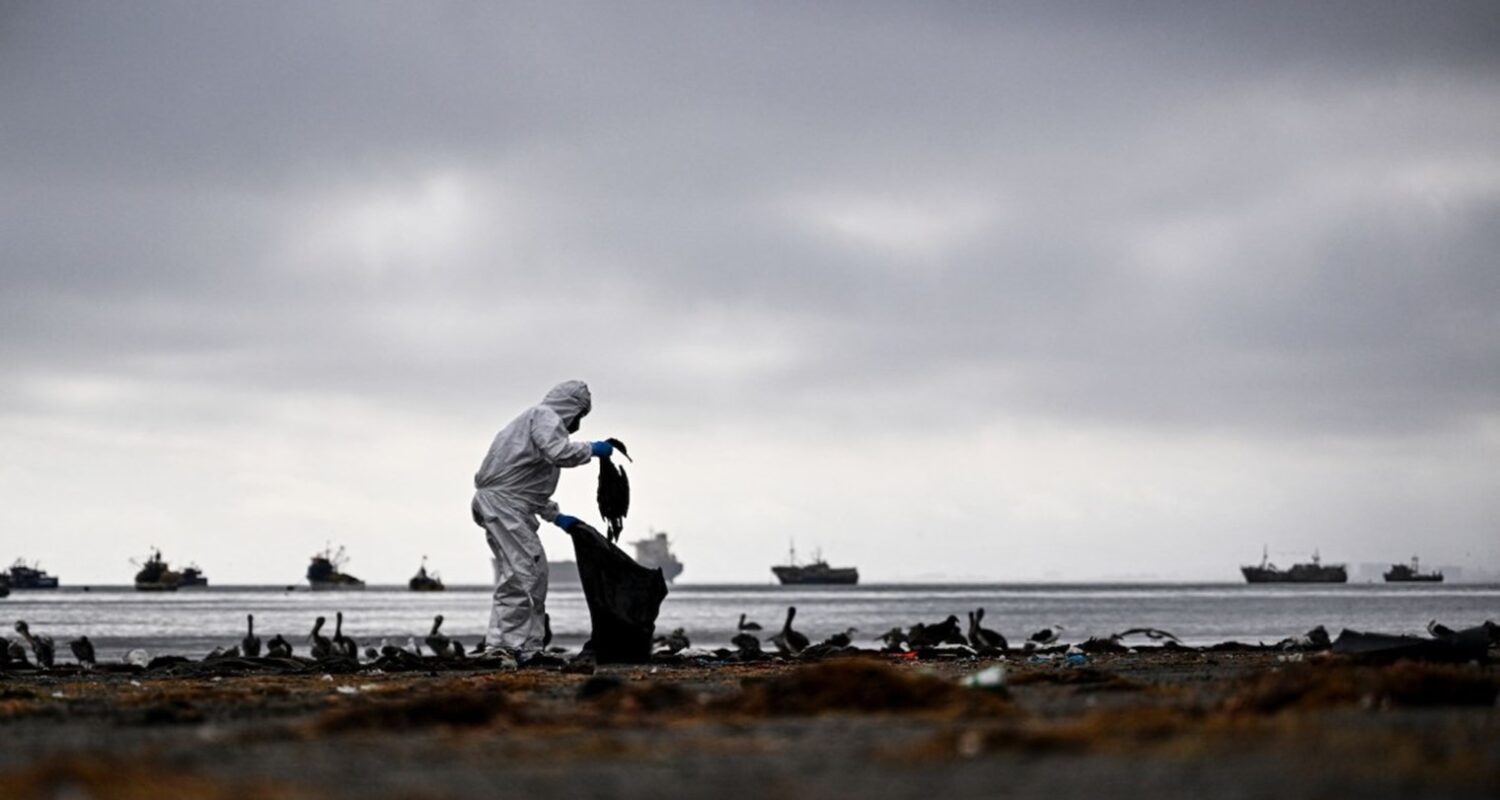Oliver Whang
As avian influenza spreads to the farthest reaches of the planet, scientists have expressed both urgency and fatalism.
April 14, 2024

Martin Bernetti/AFP/Getty Images
An employee of Chile’s Agricultural and Livestock Service removing a dead Guanay cormorant from a beach in Coquimbo, May 29, 2023 Facebook Twitter Mail to Print page
In August 2023 dead elephant seals washed ashore on beaches in Argentina. First a handful appeared outside Rio Grande, a coastal city on the eastern side of the Tierra del Fuego archipelago. The next day there were more. Then the sightings moved up the seaboard, from Rio Gallegos to the Chubut province to Rio Negro to Buenos Aires. Park rangers saw pregnant seals head toward the shore, seize up in the water, spasm, and drown.
Later that month, an Argentine veterinarian named Marcela Uhart traveled out to Península Valdés, a flat mushroom-shaped peninsula jutting into the Atlantic that serves as a popular seal breeding ground. Raised on a ranch in the pampas, Uhart has studied fauna in the region for nearly thirty years; she currently works in Patagonia for the University of California, Davis. Arriving at the peninsula, she found over a thousand dead seal pups, their bodies rotting into the sand. “It was surreal,” she told me last month. “The beach [was] filled with carcasses, scattered individuals, sick and dying, pups that were caught by the tide.”
It was quickly ascertained that the seals were dying after contracting the 2.3.4.4b strain of the H5N1 virus—a highly pathogenic, deadly version of the avian flu. (The “H” in the name corresponds to the hemagglutinin antigens that bind the virus to the surface of cells, the “N” to the neuraminidase proteins that help release the virus from infected cells.) The previous fall Peru’s Ministry of Health had reported pelicans sick with bird flu off the western coast of South America; in the winter researchers had found sea lions wasted on the Chilean shore. No one knew how the flu had traveled from one side of the continent to the other. Scientists theorized that it was passed through predation or waste, or physical proximity to sick animals, but the specific mechanisms of promulgation were unclear. On Punta León, a sharp cape below Península Valdés, the beach was strewn with dead terns, even as seagulls picked at the bodies, seemingly unaffected. Some had pulled lifeless creatures into their nests to use as cushions.
By summer, when Uhart first heard about the seals in Argentina, H5N1 had spread to every continent except Antarctica and Australia, appearing in both mammals and birds. Scientists were monitoring the situation closely. More than a hundred million birds breed on the Antarctic mainland and its surrounding islands every year, including boobies, cormorants, petrels, gulls, and sandpipers. Some species, like the snowy albatross and the emperor penguin, nest in the region exclusively. In a closely connected polar ecosystem—where fur seals hunt birds, leopard seals eat fur seal pups, and organisms slip in and out of the water from icy shores—a new disease can be catastrophic. “If the virus does start to cause mass mortality events across penguin colonies, it could signal one of the largest ecological disasters of modern times,” a group of British researchers wrote last year in a paper documenting the flu’s southward proliferation.
Since they neither had a solid understanding of how the virus spread nor knew of a way to stop it, all scientists could do was wait for news to arrive. In the fall, it did. Members of the British Antarctic Survey discovered a pair of infected skuas on the Antarctic mainland, making the current avian influenza epidemic the deadliest and most wide-ranging outbreak of its kind in history.
By the time I spoke to Uhart, the breeding season in Patagonia had ended. Over 17,000 baby elephant seals—96 percent or more of the juveniles in the region—were estimated to have died, as well as more than 500,000 birds. In some areas there were no longer any organisms to infect. Still, Uhart told me, she saw sick and dead animals on each visit to the beach: a sea lion, a duck, a tern. “My suspicion is that the virus will linger on,” she said. “We just don’t know whether it will continue to cause epidemic outbreaks, or whether it will just trickle in like it is now.”
The story was different in Antarctica, where Uhart was heading on an expedition as part of an effort to document the farthest reaches to which the flu had spread. There had been reports of infected leopard seals and Emperor penguins, but tissue samples would have to be gathered and tested to confirm them. In a frozen, sparsely populated area, access would be difficult, updates would lag behind actual infections and deaths, and much of the impact would need to be extrapolated using predictive models. All the same, the potential for calamity was clear. “There’s never been such an event in Antarctica before,” Uhart told me. “This could be a mass extinction.”
*
H5N1 was first discovered in 1996 in a farmed goose in Guangdong, China. Over the next year it spread through animal markets and farms, eventually making its way to Hong Kong, where it spilled over into humans. In 1997 eighteen people were reported to have caught it; six died. For the next two decades, the “Goose Guangdong virus,” as it came to be known, spread around Asia, Europe and Africa, first among poultry, then among swans, parrots, guineafowl, flamingos, ducks, grebes, and more.
Advertisement
Like many viruses, bird flu moves like a rumor: it changes as organisms contract it. This makes poultry farms, where tens of thousands of birds are kept near each other, particularly crucial inflection points in the evolution of the disease. Often spreading through wild birds in a mild form, the virus turns lethal in captivity. These highly pathogenic versions of bird flu infect an animal’s entire body: heads swell, coordination dissolves, extremities turn purple.
As bird flu spread from farms to the wild and back, it mutated several times, often reassorting, or combining genetic material, with other viruses, and then reassorting with strains of the original virus that had evolved in parallel. By 2020 the phylogenetic tree of the earliest Goose Guangdong virus had gone global many times over, fragmenting into hundreds of slightly modified versions. That fall the disease broke out in Europe, first in wild birds, then in poultry. It quickly spread to Africa and Asia, and in January 2022 the first case of H5N1 in six years was discovered in the United States, in a wigeon in South Carolina. Within a month the virus was reported on turkey farms. Then it popped up in South America.
The current outbreak has attracted such concern not only because of the disastrous threat it poses to wildlife and farmed birds but also because deadly diseases in humans often start, in some form, in animals. Influenza, HIV, Ebola, and the Bubonic plague all likely have roots in human-animal interactions. Sometimes wild animals act as reservoirs for a disease, and a single encounter can set the virus loose among humans; in other cases, like that of Covid-19, the disease gestates and evolves in animals under human care. The effect that these diseases have on humans depends on several factors, most importantly their ease of transmission. Covid-19’s infectiousness and long incubation period combine to make its spread rapid and
difficult to track. Ebola, on the other hand, is passed from person to person more slowly, through bodily fluids, and people often die before it can spread widely.
Among humans, avian flu is deadly but so far not particularly infectious. Since 2003 there have been over 860 human cases of H5N1, 52 percent of them fatal; confirmed cases of human-to-human proliferation remain sparse. But the difference between a virus that infects chickens and one that infects humans can be a handful of nucleotides passed between broiler hens in adjacent cages. Factory farms are in this sense essentially labs for malignant pathogens, with hundreds of thousands of immobilized test subjects. Last month bird flu was detected in American dairy cows; a week later, in Texas, it was diagnosed in a human.
The method of mass poultry disease control recommended by the American Veterinary Medical Association under “constrained circumstances” is called “Ventilation Shutdown plus.” It consists of killing any birds potentially exposed to the disease by cutting off the airflow to their sheds and jacking up temperatures inside or flooding the space with carbon dioxide. VSD+ is cheap and efficient, which is significant because livestock deaths from avian flu cost American farmers—and the government, by virtue of farming subsidies—billions of dollars. (Since the 1990s, estimates place the global cost of outbreaks at around $80 billion.) But animals subjected to VSD+ tend to suffocate slowly, over the course of hours, as a result of which a number of animal welfare organizations have protested the method. “It can take hours of profound suffering for animals to finally die,” Vicky Bond, a veterinarian and president of The Humane League, said in 2022. In April of that year, a farm in Iowa killed 5.3 million chickens with VSD+ within twenty-four hours of detecting bird flu. “They cooked those birds alive,” one employee told The Guardian.



